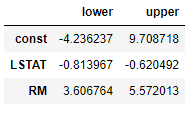I want to get a confidence interval of the result of a linear regression. I'm working with the boston house price dataset.
I've found this question: How to calculate the 99% confidence interval for the slope in a linear regression model in python? However, this doesn't quite answer my question.
Here is my code:
import numpy as np
import matplotlib.pyplot as plt
from math import pi
import pandas as pd
import seaborn as sns
from sklearn.datasets import load_boston
from sklearn.model_selection import train_test_split
from sklearn.linear_model import LinearRegression
from sklearn.metrics import mean_squared_error, r2_score
# import the data
boston_dataset = load_boston()
boston = pd.DataFrame(boston_dataset.data, columns=boston_dataset.feature_names)
boston['MEDV'] = boston_dataset.target
X = pd.DataFrame(np.c_[boston['LSTAT'], boston['RM']], columns=['LSTAT', 'RM'])
Y = boston['MEDV']
# splits the training and test data set in 80% : 20%
# assign random_state to any value.This ensures consistency.
X_train, X_test, Y_train, Y_test = train_test_split(X, Y, test_size=0.2, random_state=5)
lin_model = LinearRegression()
lin_model.fit(X_train, Y_train)
# model evaluation for training set
y_train_predict = lin_model.predict(X_train)
rmse = (np.sqrt(mean_squared_error(Y_train, y_train_predict)))
r2 = r2_score(Y_train, y_train_predict)
# model evaluation for testing set
y_test_predict = lin_model.predict(X_test)
# root mean square error of the model
rmse = (np.sqrt(mean_squared_error(Y_test, y_test_predict)))
# r-squared score of the model
r2 = r2_score(Y_test, y_test_predict)
plt.scatter(Y_test, y_test_predict)
plt.show()
How can I get, for instance, the 95% or 99% confidence interval from this? Is there some sort of in-built function or piece of code?

